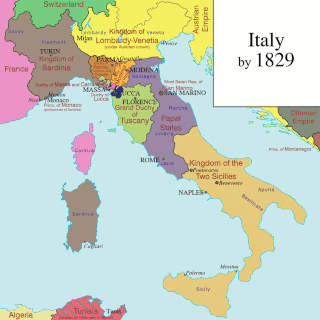Italian unification
creation of the politically and administratively integrated nation of Italy (1815–1871) From Wikipedia, the free encyclopedia
Italian unification (Italian: Unità d'Italia), also known as the Risorgimento (meaning "the Resurgence"), refers to the Italian movement that united the Italian states in the 19th century.
 Map showing the unification of Italy, 1829–1871 | |
| Native name | Unità d'Italia |
|---|---|
| Date | 1815–1871 |
| Location | Italy |
| Also known as | Risorgimento |
Napoléon Bonaparte invaded Italy in 1796 and later controlled it. When he was defeated in 1815 at the Battle of Waterloo, the free states could now join together. The Congress of Vienna (1814–1815) restored the prewar ancien régime. The Austrian Empire, ruled by the Habsburgs, controlled much of Italy.[1]
The movement ended in 1871, when Rome became the capital of the Kingdom of Italy by the efforts of Giuseppe Garibaldi, an Italian national hero who united southern Italy.[2][3] That allowed King Victor Emmanuel II to become the first king of Italy.
Italy after 1815
 Papal States
Papal States Kingdom of Sardinia
Kingdom of Sardinia Kingdom of the Two Sicilies
Kingdom of the Two Sicilies Kingdom of Lombardy–Venetia (under Austrian Empire)
Kingdom of Lombardy–Venetia (under Austrian Empire) Kingdom of Illyria (under Austrian Empire)
Kingdom of Illyria (under Austrian Empire) Grand Duchy of Tuscany
Grand Duchy of Tuscany Duchy of Parma, Piacenza and Guastalla
Duchy of Parma, Piacenza and Guastalla Duchy of Modena and Reggio
Duchy of Modena and Reggio Duchy of Massa and Carrara
Duchy of Massa and Carrara Duchy of Lucca
Duchy of Lucca Principality of Monaco
Principality of Monaco- Republic of San Marino
 Republic of Cospaia
Republic of Cospaia Republic of San Marco
Republic of San Marco Roman Republic
Roman Republic United Provinces of Central Italy
United Provinces of Central Italy
Conquest of Sardinia
Victor Emmanuel II and Camillo Benso, Count of Cavour, some of main figures in Italian unification.
Victor Emmanuel II had a great vision of a unified Italy. He wanted the Kingdom of-Sardinia to be a model for the unification of Italy. To do so, he started many public works, projects and political reforms. Sardinia was soon recognized as an emerging power. The next step for its conquest was to get Austria out of the Italian Peninsula.
When the Crimean War broke out with France and United Kingdom against Russia, Sardinia had a chance to earn some respect and to make a name for itself. After Russia lost, Sardinia attended the peace conference. As a result, Sardinia gained the support of French Emperor Napoléon III.
War against Austria
In 1858, Sardinia and France secretly plotted a plan of attack against Austria. The following year, Sardinia put its plan into action. Instead of attacking, Sardinia encouraged nationalist revolts in the Austrian-held territories in Italy to provoke Austria into starting the war. After the Battles of Magenta and Solferino, France drove Austria out of Lombardy, but Austria still held onto Venetia.
France then dropped out of the war since it feared a unified Italy being a threat and realised that the Austrian strength was too great. The end of the war let Austria keep Venetia.
Completion of unification
Meanwhile, the Italian nationalist Giuseppe Garibaldi led a nationalist uprising to join the states together into one republic. As Sardinia ended the war, Garibaldi gave most of the provinces to it. In March 1861, a parliament of all of Italy except Rome and Venetia agreed to unify Italy, with Victor Emmanuel II as its first king. When Prussia defeated Austria in a war in 1866, Italy struck a deal to force Austria to turn over Venetia, which left Rome as the last major Italian city that was not included.
Franco-Prussian War
Because of the Franco-Prussian War in 1870, France sent its army away from Rome. Without protection, the Pope could not resist Italy, and Rome finally became the capital of Italy.
Related pages
References
Other websites
Wikiwand - on
Seamless Wikipedia browsing. On steroids.


